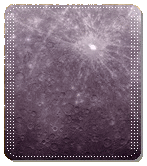
 | First, historical picture of Mercury taken from orbit by MESSENGER on March 29th, 2011, the first picture ever obtained from a craft orbiting the innermost planet of the solar system. picture NASA/Johns Hopkins University Applied Physics Laboratory/Carnegie Institution of Washington |
Mercury had been visited once, by the Mariner 10 mission by 1974, only. MESSENGER (for 'MErcury Surface, Space ENvironment, GEochemistry, and Ranging'), a NASA mission, was deviced like a mission to lead a thorough study of Mercury orbiting in an extremely elliptical orbit bringing the craft from 120 miles above the planet to 9,000 miles away. Messenger launched August 3rd, 2004 from the Cape Canaveral Air Force Station, in Florida. It settled into a definitive orbit about Mercury in March 2011 after three flybys of the planet in January and October 2008, and September 2009, as the craft had performed three gravity assists (two at Venus in October 2006 and June 2007, one at Earth in 2005)
Mercury is closest planet to Sun in the solar system, orbiting 36 million miles from our star. Mercury as it is located between us and the Sun always was difficult to observe from the Earth, as it never venture away from the horizon after sunset or before sunrise, like a evening or a morning star. Mariner 10 provided 12,000 pictures, mapping about 45 percent of the planet. Mercury is 3202 miles wide (i.e. one third more than Moon and a little less than Earth's half). Mercury orbits the Sun in 88 days. As Sun progressively slowed its self-rotation, the latter became locked with the revolution period leading to a Mercury day at Mercury lasting 175 days. One benefit of the mission is that, as Earth, Venus, and Mars have been well explored, Messenger will complete the data at Mercury. Thus scientists will better undestand what processes most had the inner planets turn out different after they had a period of similar formation
click to a illustration of MESSENGERís complex series of gravity assists before entering orbit around Mercury, and to a illustration showing MESSENGERís science instruments
Originally planned to work during one year in orbit at Mercury, MESSENGER did during 4 as it eventually was slammed into Mercuryís surface at about 8,750 mph on April 30th, 2015 as the probe hit the side of the planet facing away from Earth. The mission had run out of propellant as a series of orbit correction maneuvers prepared the descent or the mission performed last studies of the magnetic anomalies at Mercury. A return journey of a command sent to MESSENGER is taking between 4-12 minutes, depending on the distance from Earth. Of note that the upcoming, ESA BepiColombo mission will benefit of MESSENGER data; both missions further, generally complement each other in terms of science. MESSENGER main instrument, the wide-angle camera (WAC), not a typical color camera, could image in 11 colors, ranging from 430 to 1020 nm wavelength, or from the visible through near-infrared, using a filter wheel as 8 filters only were used. WAC images were used in coordination with the Mercury Atmospheric and Surface Composition Spectrometer (MASCS), a hyperspectral instrument that provides reflectance information at many more wavelengths
MESSENGER, during its long, 7-year journey to Mercury, first sent science results as, once the mission settled into its Mercurian orbit, it brought a wealth of data which greatly improved our knowledge of Mercury!
Website Manager: G. Guichard, site 'Amateur Astronomy,' http://stars5.6te.net. Page Editor: G. Guichard. last edited: 1/27/2016. contact us at ggwebsites@outlook.com